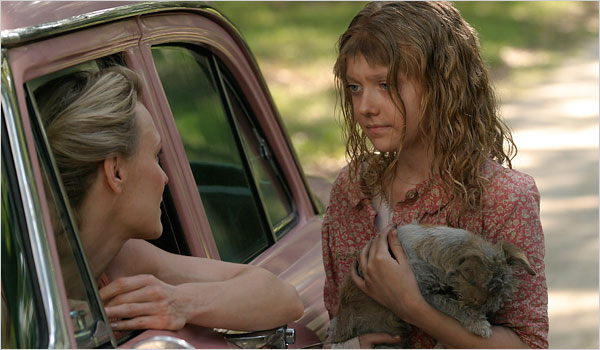|
Reviews of Recent Independent, Foreign, & Documentary Films in Theaters and DVD/Home Video

HOUNDDOG Dakota Fanning has hit that transitional age for child actors—about the same age when Brooke Shields and Jodie Foster played child prostitutes. Hounddog, a film shot in the summer of 2006, is Fanning’s Taxi Driver or Pretty Baby. It’s the story of a poor, motherless preteen girl in the 1950s American South whose transition from childhood to adulthood is marked by a rape. In it, Fanning is called upon to show her grown-up acting chops. At the same time, her casting has some publicity stunt qualities, practically taunting audiences into outrage. Two big questions come to mind before seeing the already infamous “Dakota Fanning rape movie”: does Fanning have the maturity and range to play a role like this? And, does the movie earn its keep? Meaning, does Hounddog have enough substance, depth, and narrative strength to make it more than a collector’s item akin to the underwhelming Paris Hilton sex tape? The answer to the first question is an emphatic yes. Fanning is extraordinary as Lewellen, a 12-year-old Elvis fan who is utterly transformed when she’s violated. Early in the movie, Lewellen does an unselfconscious, heartfelt impression of Elvis singing “Hound Dog,” happily gyrating without awareness or fear of how her body might be perceived. When an older boy says he’ll give her a ticket to an Elvis concert if she takes off all her clothes and does the impression, she’s almost unfazed. She finds it strange, but doesn’t understand why. After he rapes her, she loses her ability to sing a note, and Fanning’s performance of this terrible transition is deep and true. I’m still on the fence about the second question. Writer-director Deborah Kampmeier clearly wanted to make a film that addressed the horror of sexual assault and the healing power of art (in this case, blues music.) Her first film, Virgin (2003), also features a teen rape victim. Hounddog is a strong study of the profound effects of rape, and also an interesting parable about victimization in general. Though moving, it is also disappointing. The only reliable adult in Lewellen’s life is Charles (Afemo Omilami), a wise black caretaker who teaches her about poisonous snakes, music, and life. He helps her understand that people will always try to abuse you, put you down, or make you feel “less than.” The Charles character, in all his goodness, is a politically correct creation. All of the black people in Hounddog are wise, moral, and kind, as if the film’s grasp of its themes is too fragile to abide the challenge of more complexity and naturalism. (The wise black man coming along to heal a white protagonist borders on being a racist cliché, and is more offensive than anything that happens during the rape.) An early scene, when Fanning comes across a room of black blues musicians and smiles glowingly as she hears the real music that Elvis co-opted, is unpleasantly saccharine and has a minstrel show quality, as if these human beings and their lives and art exist solely on Lewellen’s behalf. The fanatically religious grandma (Piper Laurie), the drunken father (David Morse), and the incessant snake metaphors all have an overdone quality, as if some 12-year-old from present-day Chicago fantasized about the ’50s South and whipped up a script. The choice to resort to clichés is strange, given that Kampmeier grew up in Tennessee and Georgia. Then again,
if you take the tritely Southern gothic backdrop as a metaphorical
device rather than a true setting—as a way to frame the film’s main
story, about rape and recovery—it becomes more convincing and a wholly
transcendent movie. Viewers in search of a morally complex, layered, and
intensely accurate exploration of the effects of childhood rape should
turn to Allison Anders’ Things Behind the Sun (2001.) Hounddog,
despite the controversy, the poisonous snakes, and Fanning’s
fully-realized performance, is harmless.
Elizabeth Bachner
|

